brake TOYOTA PRIUS PLUG-IN 2013 User Guide
[x] Cancel search | Manufacturer: TOYOTA, Model Year: 2013, Model line: PRIUS PLUG-IN, Model: TOYOTA PRIUS PLUG-IN 2013Pages: 704, PDF Size: 19.59 MB
Page 52 of 704

23
PRIUS PHV_OM_OM47787U_(U)
Installation of a mobile two-way radio system
The installation of a mobile two-way radio system in your vehicle could affect
electronic systems such as:
●Multiport fuel injection system/sequential multiport fuel injection system
●Cruise control system
●Anti-lock brake system
●SRS airbag system
●Seat belt pretensioner system
Be sure to check with your Toyota dealer for precautionary measures or spe-
cial instructions regarding installation.
High voltage parts and cables on the hybrid vehicles emit approximately the
same amount of electromagnetic waves as the conventional gasoline pow-
ered vehicles or home electronic appliances despite of their electromagnetic
shielding.
Unwanted noise may occur in the reception of the mobile two-way radio.
Page 53 of 704

24
PRIUS PHV_OM_OM47787U_(U)
Ve h i c l e d a ta r e c o r d i n g s
Yo u r To y o t a i s e q u i p p e d w i t h s e v e r a l s o p h i s t i c a t e d c o m p u t e r s t h a t w i l l r e c o r d
certain data, such as:
•Engine speed
•Electric motor speed (traction motor speed)
• Accelerator status
•Brake status
•Vehicle speed
•Shift position
•Hybrid battery (traction battery) status
The recorded data varies according to the vehicle grade level and options
with which it is equipped. Furthermore, these computers do not record con-
versations, sounds or pictures.
●Data usage
To y o t a m a y u s e t h e d a t a r e c o r d e d i n t h e s e c o m p u t e r s t o d i a g n o s e m a l f u n c -
tions, conduct research and development, and improve quality.
To y o t a w i l l n o t d i s c l o s e t h e r e c o r d e d d a t a t o a t h i r d p a r t y e x c e p t :
• With the consent of the vehicle owner or with the consent of the lessee if
the vehicle is leased
•In response to an official request by the police, a court of law or a govern-
ment agency
•For use by Toyota in a lawsuit
•For research purposes where the data is not tied to a specific vehicle or
vehicle owner
●Usage of data collected through Safety Connect (U.S. mainland only)
If your Toyota has Safety Connect and if you have subscribed to those ser-
vices, please refer to the Safety Connect Telematics Subscription Service
Agreement for information on data collected and its usage.
Page 54 of 704

25
PRIUS PHV_OM_OM47787U_(U)
Event data recorder
This vehicle is equipped with an event data recorder (EDR). The main pur-
pose of an EDR is to record, in certain crash or near crash-like situations,
such as an air bag deployment or hitting a road obstacle, data that will assist
in understanding how a vehicle’s systems performed. The EDR is designed
to record data related to vehicle dynamics and safety systems for a short
period of time, typically 30 seconds or less.
The EDR in this vehicle is designed to record such data as:
•How various systems in your vehicle were operating;
• Whether or not the driver and passenger safety belts were buckled/fas-
tened;
•How far (if at all) the driver was depressing the accelerator and/or brake
pedal; and,
•How fast the vehicle was traveling.
These data can help provide a better understanding of the circumstances in
which crashes and injuries occur.
NOTE: EDR data are recorded by your vehicle only if a nontrivial crash situa-
tion occurs; no data are recorded by the EDR under normal driving condi-
tions and no personal data (e.g., name, gender, age, and crash location) are
recorded. However, other parties, such as law enforcement, could combine
the EDR data with the type of personally identifying data routinely acquired
during a crash investigation.
To r e a d d a t a r e c o r d e d b y a n E D R , s p e c i a l e q u i p m e n t i s r e q u i r e d , a n d a c c e s s
to the vehicle or the EDR is needed. In addition to the vehicle manufacturer,
other parties, such as law enforcement, that have the special equipment, can
read the information if they have access to the vehicle or the EDR.
Page 66 of 704
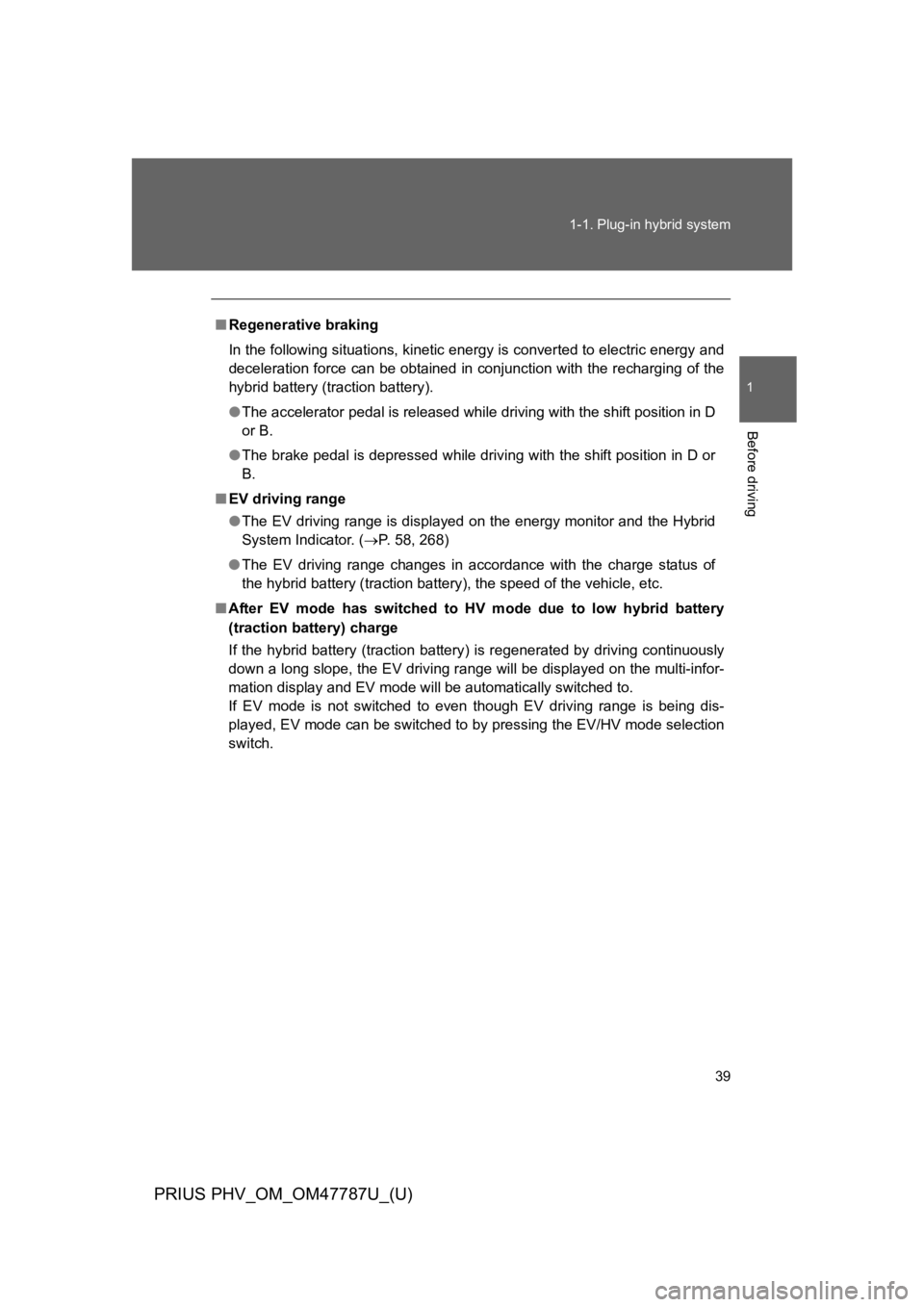
39
1-1. Plug-in hybrid system
1
Before driving
PRIUS PHV_OM_OM47787U_(U)
■Regenerative braking
In the following situations, kinetic energy is converted to electric energy and
deceleration force can be obtained in conjunction with the recharging of the
hybrid battery (traction battery).
●The accelerator pedal is released while driving with the shift position in D
or B.
●The brake pedal is depressed while driving with the shift position in D or
B.
■EV driving range
●The EV driving range is displayed on the energy monitor and the Hybrid
System Indicator. (→P. 5 8 , 2 6 8 )
●The EV driving range changes in accordance with the charge status of
the hybrid battery (traction battery), the speed of the vehicle, etc.
■After EV mode has switched to HV mode due to low hybrid battery
(traction battery) charge
If the hybrid battery (traction battery) is regenerated by driving continuously
down a long slope, the EV driving range will be displayed on the multi-infor-
mation display and EV mode will be automatically switched to.
If EV mode is not switched to even though EV driving range is being dis-
played, EV mode can be switched to by pressing the EV/HV mode selection
switch.
Page 69 of 704

42
1-1. Plug-in hybrid system
PRIUS PHV_OM_OM47787U_(U)
■Sounds and vibrations specific to a hybrid vehicle
There may be no engine sounds or vibration even though the vehicle is able
to move. For safety, apply the parking brake and make sure to shift the shift
position to P when parked.
The following sounds or vibrations may occur when the hybrid system is
operating, and are not a malfunction.
●The brake system operation sound heard from the front of the vehicle
when the driver’s door is opened.
●Motor sounds may be heard from the engine compartment.
●Sounds may be heard from the hybrid battery (traction battery) behind
the rear seat when the hybrid system starts or stops.
●Sounds may be heard from the transmission when the gasoline engine
starts or stops, when driving at low speeds, or during idling.
●Engine sounds may be heard when accelerating sharply.
●Sounds may be heard due to regenerative braking when you press the
brake pedal or release the accelerator pedal.
●Vibration may be felt when the gasoline engine starts or stops.
●Cooling fan sounds may be heard from the air intake vent. (→P. 4 5 )
●The operation sound of the air conditioning system (air conditioning com-
pressor, blower motor).
Page 76 of 704
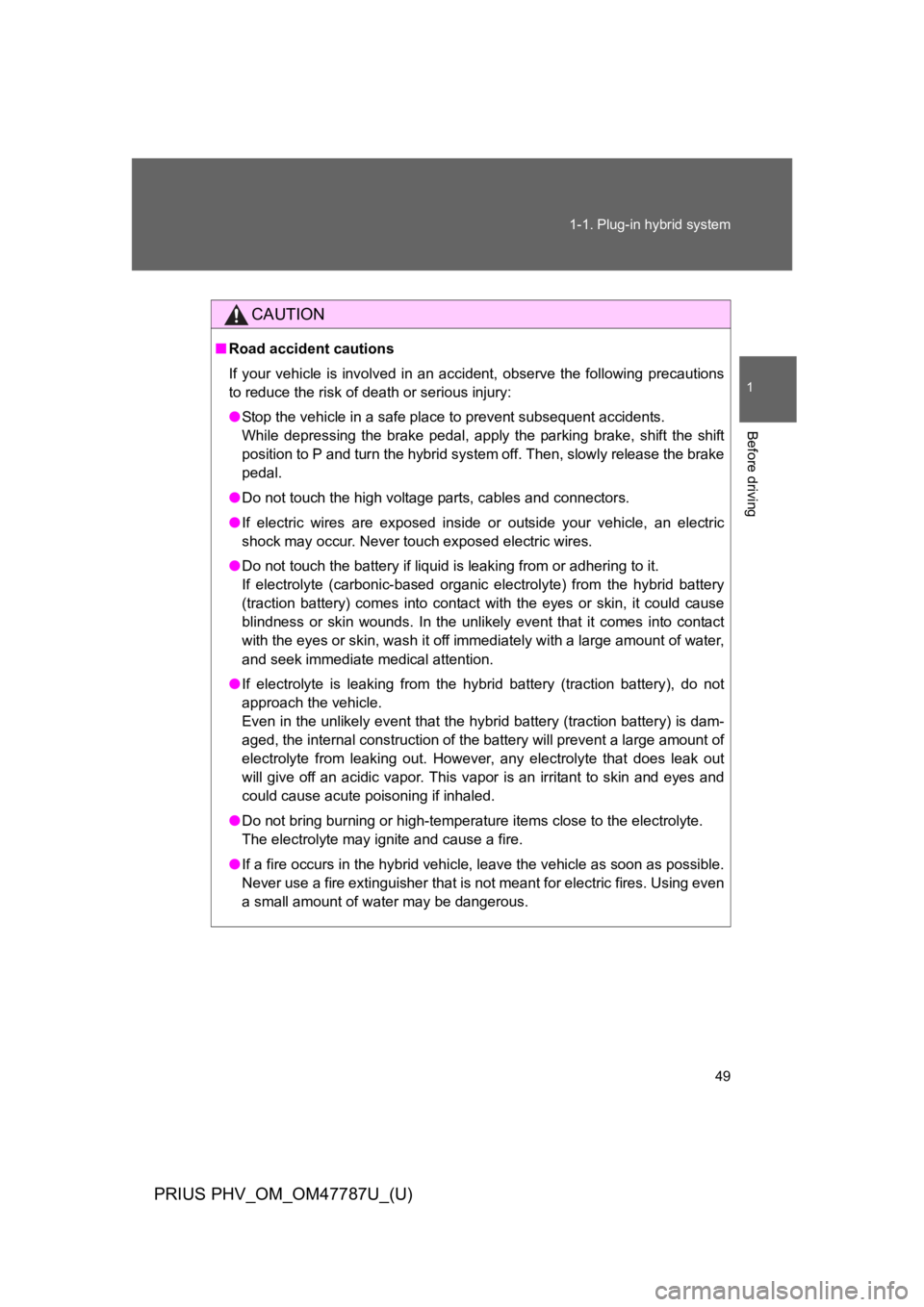
49
1-1. Plug-in hybrid system
1
Before driving
PRIUS PHV_OM_OM47787U_(U)
CAUTION
■Road accident cautions
If your vehicle is involved in an accident, observe the following precautions
to reduce the risk of death or serious injury:
●Stop the vehic le in a safe place to prevent subsequent accidents.
While depressing the brake pedal, apply the parking brake, shift the shift
position to P and turn the hybrid system off. Then, slowly release the brake
pedal.
●Do not touch the high voltage parts, cables and connectors.
●If electric wires are exposed inside or outside your vehicle, an electric
shock may occur. Never touch exposed electric wires.
●Do not touch the battery if liquid is leaking from or adhering to it.
If electrolyte (carbonic-based organic electrolyte) from the hybrid battery
(traction battery) comes into contact with the eyes or skin, it could cause
blindness or skin wounds. In the unlikely event that it comes into contact
with the eyes or skin, wash it off immediately with a large amount of water,
and seek immediate medical attention.
●If electrolyte is leaking from the hybrid battery (traction battery), do not
approach the vehicle.
Even in the unlikely event that the hybrid battery (traction battery) is dam-
aged, the internal construction of the battery will prevent a large amount of
electrolyte from leaking out. However, any electrolyte that does leak out
will give off an acidic vapor. This vapor is an irritant to skin and eyes and
could cause acute poisoning if inhaled.
●Do not bring burning or high-temperature items close to the electrolyte.
The electrolyte may ignite and cause a fire.
●If a fire occurs in the hybrid vehicle, leave the vehicle as soon as possible.
Never use a fire extinguisher that is not meant for electric fires. Using even
a small amount of water may be dangerous.
Page 94 of 704
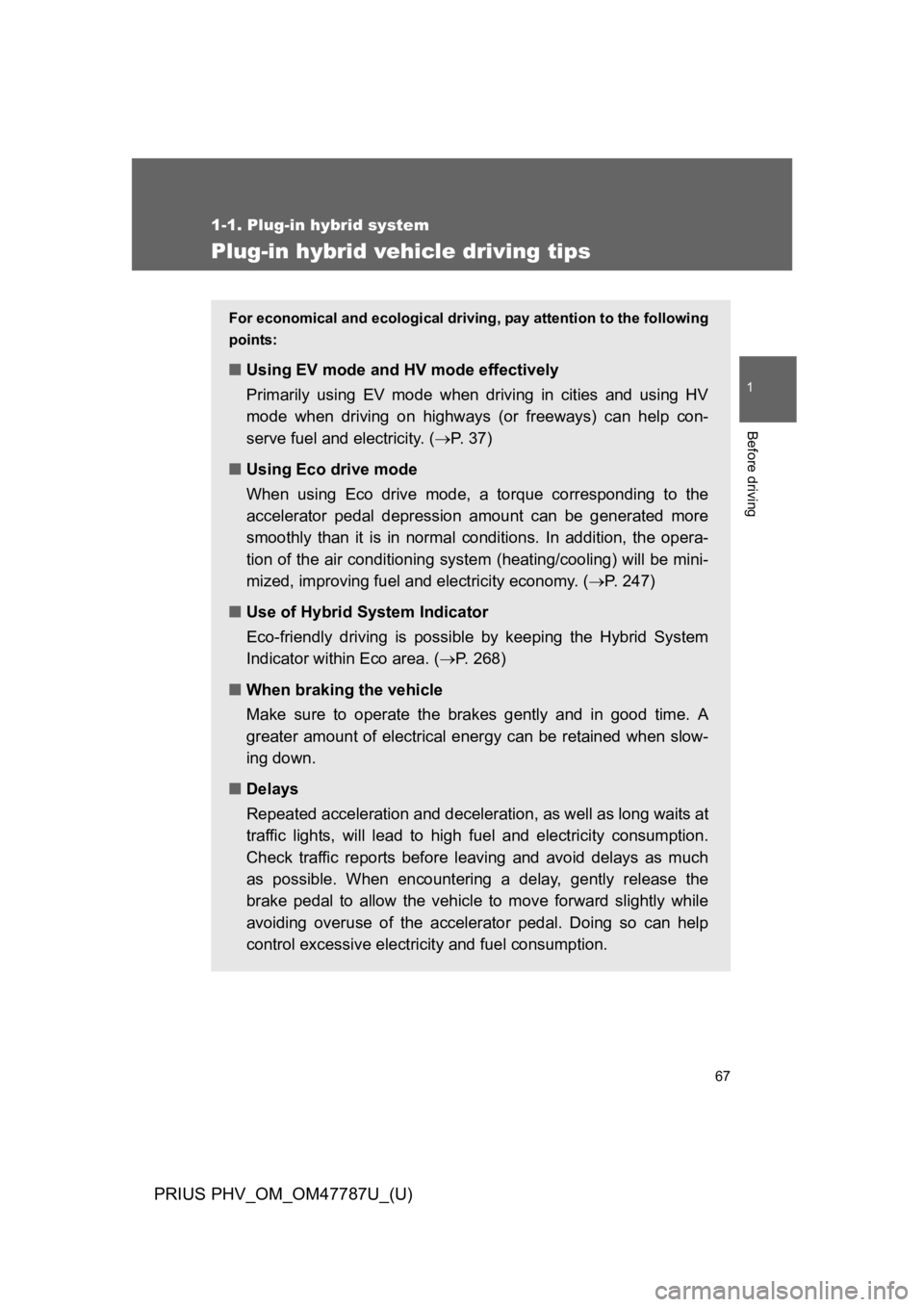
67
1
1-1. Plug-in hybrid system
Before driving
PRIUS PHV_OM_OM47787U_(U)
Plug-in hybrid vehicle driving tips
For economical and ecological driving, pay attention to the following
points:
■Using EV mode and HV mode effectively
Primarily using EV mode when driving in cities and using HV
mode when driving on highways (or freeways) can help con-
serve fuel and electricity. (→P. 3 7 )
■Using Eco drive mode
When using Eco drive mode, a torque corresponding to the
accelerator pedal depression amount can be generated more
smoothly than it is in normal conditions. In addition, the opera-
tion of the air conditioning system (heating/cooling) will be mini-
mized, improving fuel and electricity economy. (→P. 2 4 7 )
■Use of Hybrid System Indicator
Eco-friendly driving is possible by keeping the Hybrid System
Indicator within Eco area. (→P. 2 6 8 )
■When braking the vehicle
Make sure to operate the brakes gently and in good time. A
greater amount of electrical energy can be retained when slow-
ing down.
■Delays
Repeated acceleration and deceleration, as well as long waits at
traffic lights, will lead to high fuel and electricity consumption.
Check traffic reports before leaving and avoid delays as much
as possible. When encountering a delay, gently release the
brake pedal to allow the vehicle to move forward slightly while
avoiding overuse of the accelerator pedal. Doing so can help
control excessive electricity and fuel consumption.
Page 95 of 704

68
1-1. Plug-in hybrid system
PRIUS PHV_OM_OM47787U_(U)
■Highway driving
Control your speed and keep at a constant speed. Also, before
stopping at a toll booth or similar, allow plenty of time to release
the accelerator and gently apply the brakes. A greater amount of
electrical energy can be retained when slowing down.
Electricity consumption will increase substantially when driving
at high speeds in EV mode. If there will be a long distance to the
next external charging point after leaving a freeway, driving in
HV mode while on the freeway and in EV mode after leaving the
freeway is recommended.
■Air conditioning on/off
●Switch the air conditioning ( ) to off when it is not
needed. Doing so can help control excessive electricity and
fuel consumption.
In summer: In high temperatures, use the recirculated air
mode. Doing so will help to reduce the burden on the air con-
ditioner and reduce fuel consumption as well.
In winter: Because the gasoline engine will not automatically
cut out until the gasoline engine and the interior of the vehicle
are warm, it will consume fuel. Also, fuel consumption can be
improved by avoiding overuse of the heater.
●For efficiency, use the Remote Air Conditioning System
before departing while the charging cable is connected.
Page 107 of 704
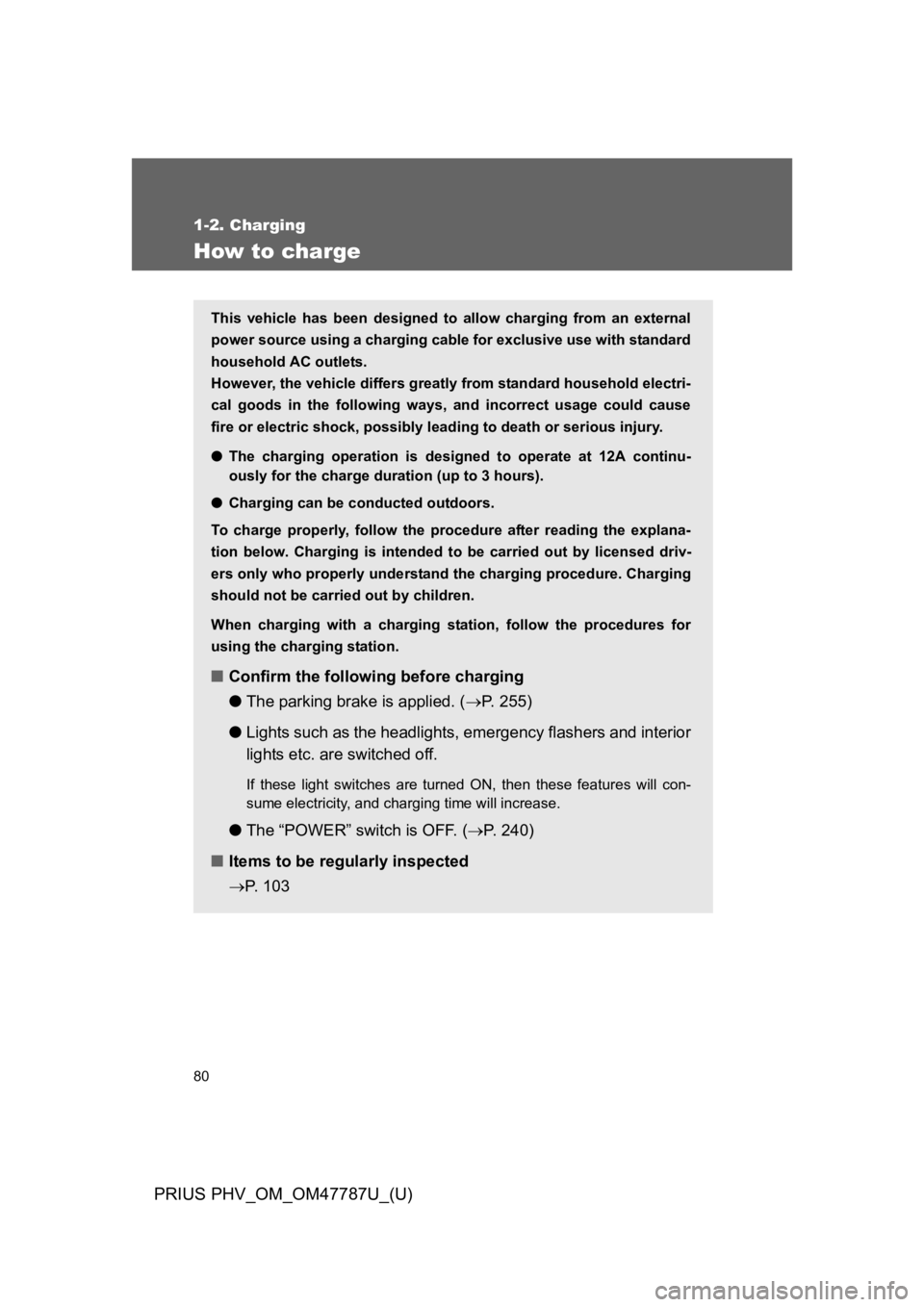
80
1-2. Charging
PRIUS PHV_OM_OM47787U_(U)
How to charge
This vehicle has been designed to allow charging from an external
power source using a charging cable for exclusive use with standard
household AC outlets.
However, the vehicle differs greatly from standard household electri-
cal goods in the following ways, and incorrect usage could cause
fire or electric shock, possibly leading to death or serious injury.
●The charging operation is designed to operate at 12A continu-
ously for the charge duration (up to 3 hours).
●Charging can be conducted outdoors.
To c h a r g e p r o p e r l y, f o l l o w t h e p rocedure after reading the explana-
tion below. Charging is intended to be carried out by licensed driv-
ers only who properly understand the charging procedure. Charging
should not be carried out by children.
When charging with a charging station, follow the procedures for
using the charging station.
■Confirm the following before charging
●The parking brake is applied. (→P. 2 5 5 )
●Lights such as the headlights, emergency flashers and interior
lights etc. are switched off.
If these light switches are turned ON, then these features will con-
sume electricity, and charging time will increase.
●The “POWER” switch is OFF. (→P. 2 4 0 )
■Items to be regularly inspected
→P. 1 0 3
Page 176 of 704
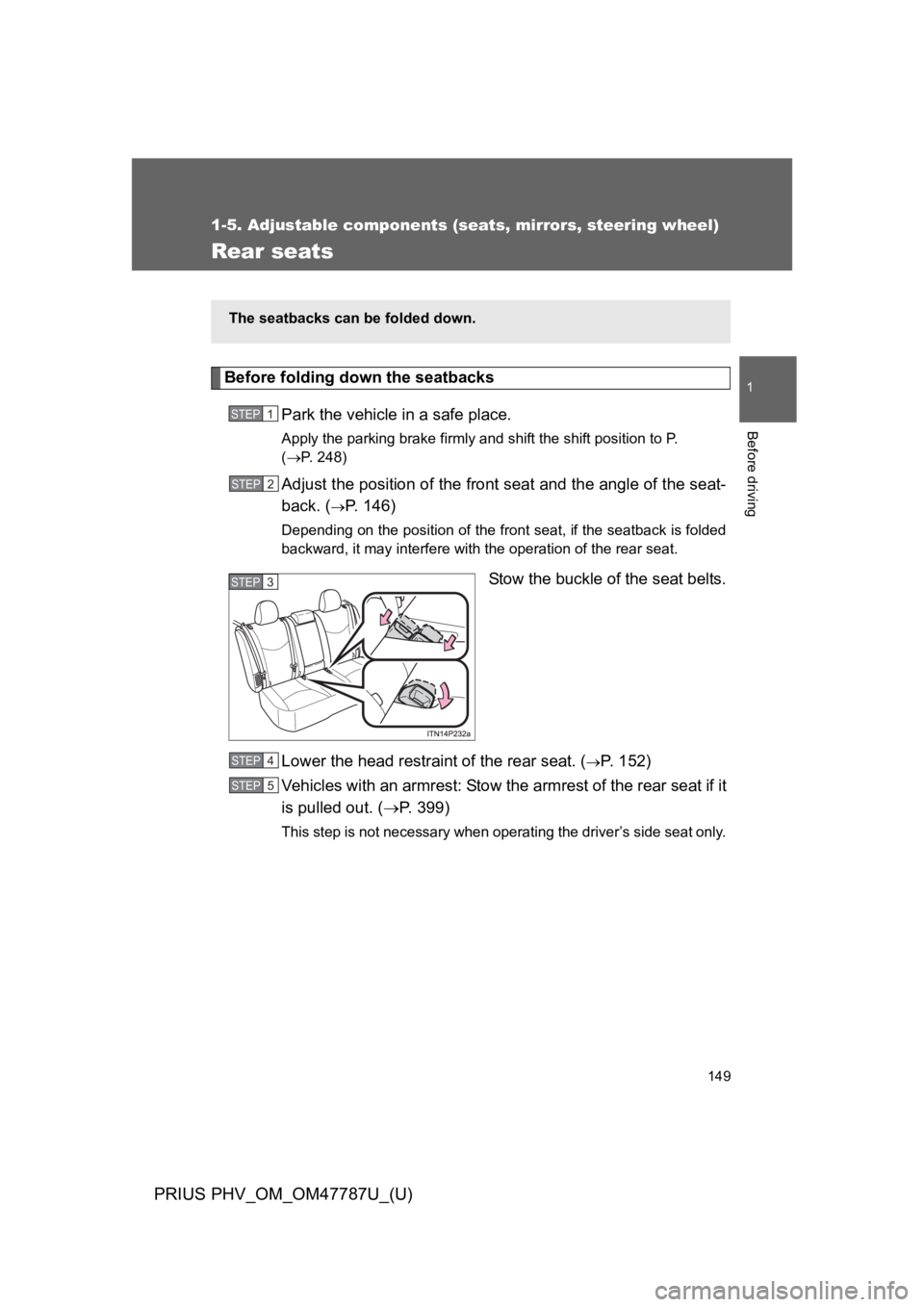
149
1
1-5. Adjustable components (seats, mirrors, steering wheel)
Before driving
PRIUS PHV_OM_OM47787U_(U)
Rear seats
Before folding down the seatbacks
Park the vehicle in a safe place.
Apply the parking brake firmly and shift the shift position to P.
(→P. 2 4 8 )
Adjust the position of the front seat and the angle of the seat-
back. (→P. 1 4 6 )
Depending on the position of the front seat, if the seatback is folded
backward, it may interfere with the operation of the rear seat.
Stow the buckle of the seat belts.
Lower the head restraint of the rear seat. (→P. 1 5 2 )
Ve h i c l e s w i t h a n a r m r e s t : St o w t h e a r m r e s t o f t h e r e a r s e a t i f i t
is pulled out. (→P. 3 9 9 )
This step is not necessary when operating the driver’s side seat only.
The seatbacks can be folded down.
STEP 1
STEP 2
STEP 3
STEP 4
STEP 5